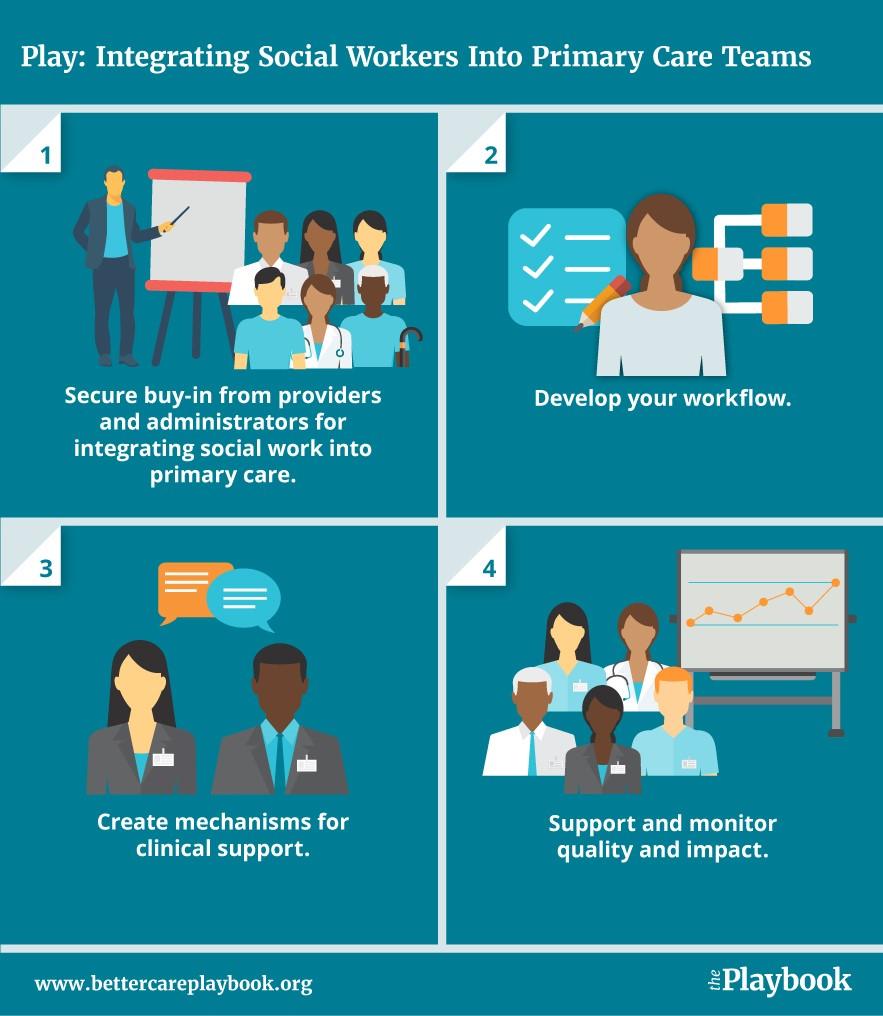Integrating social workers into primary care teams can help improve patients’ health by proactively addressing their social determinants of health and mental health needs. This integration also reduces the burden on providers and helps organizations to reach their institutional quality goals. By using patient and family engagement techniques, leveraging community-based supports, and coordinating care, social workers can improve patient self-management and ensure that psychosocial factors that influence health are addressed. To achieve and sustain successful outcomes, these initiatives should use a standardized approach derived from evidence-based and promising practices.


- Secure buy-in from providers and administrators for integrating social work into primary care
- Highlight how the initiative will help meet the needs of your patients, reduce the burden on providers, and reach quality goals that are part of contracts the clinic/institution may have.
- Align with other ongoing quality improvement efforts, such as screening for unmet social needs.
- Articulate the history and evidence base of the social work profession in identifying and addressing diverse psychosocial needs.
- Include the perspective of patients, families, and community members – those who are most likely to need and benefit from the skills and services of a social worker.
- Develop your workflow (answering the following questions)
- Whom will you be working with – what are the patient eligibility criteria?
- How will you obtain the perspective and buy-in of the people who will benefit from having a social worker on the team?
- Does the rest of the team understand the unique skills of social workers?
- What will your referral process be? Will you rely on a provider to initiate a referral to the social worker, or will there be other systematic ways of identifying patients? Is there room for adaptation as the relationship grows?
- What protocol will the social worker follow (including frequency of outreach, as well as various other aspects of the intervention mentioned in this Play)?
- How will other staff/providers (e.g., patient navigators, community health workers, RNs, etc.) interface with the social worker or otherwise be involved in the intervention?
- Will the social worker have full access to the medical record (reading and writing privileges)?
- How will the social worker communicate with the rest of the care team (e.g., regular huddles)? What is the social worker’s documentation protocol and how will the team be able to access and integrate this information in real time?
- Will the social worker’s contributions count toward any billable services, and if so, what documentation is required?
- Will the social worker provide crisis intervention services for the clinic (e.g., for suicidality)?
- Create mechanisms for clinical support
- Provide tools to guide the social worker’s psychosocial assessment, care planning, and care management.
- Train social workers to apply clinical and behavioral health techniques to care coordination and care management.
- Offer regular clinical supervision and peer consultation opportunities to social workers to ensure quality and depth of intervention.
- Support and monitor quality and impact
- Track process and outcome measures to support quality of interventions. Use these measures in a collaborative way to test out program improvements. Share successes and challenges with stakeholders often.
- Limit the use of data for punitive purposes and reinforce the motivation behind your quality assurance efforts: to improve care!
- Plan for evaluation from the beginning. How will you measure along the way to determine whether or not your interventions are having a positive impact on processes and outcomes, especially those that are most meaningful to patients? Are providers and administrators on board with this plan?
- Use SWOT (Strengths-Weaknesses-Opportunities-Threats) analysis related to the four steps described above so you can align relevant strengths and opportunities and address potential challenges.
- Make it as easy as possible for providers and staff. To be successful, the initiative must fit in with their other responsibilities, especially if there are other new initiatives underway.
- Recognize that organizational culture change can be slow, and invest in changes to embed this broadened approach to care in your policies and practices.
- Align your work with quality measures in contracts your institution may have with payers (such as Medicaid managed care or Medicare Advantage plans) and with fee-for-service billing opportunities that physicians or nurse practitioners can bill for (such as Chronic Care Management or Behavioral Health Integration codes that are recognized by Medicare, several commercial plans, and are payable to federally qualified health centers and rural health centers).
- Share success stories with stakeholders early and often – whether individual patient stories, patient or family feedback, or larger summary statistics of your process and outcome data.
For More Information
-
Rush University Medical Center has developed a standardized model to facilitate the integration of social workers into primary and specialty outpatient care: the Ambulatory Integration of the Medical and Social (AIMS) Model. To learn more about AIMS:
- Read this retrospective study comparing outcomes for AIMS to a matched comparison group: “The Ambulatory Integration of the Medical and Social (AIMS) model: A retrospective evaluation”
- Read a description of the steps of AIMS and a short case study here on the Playbook: “Are Social Workers Missing from Your Complex Care Teams?”
- Community-based organizations, including aging network organizations, are natural partners in this work! Their social work staff can embed into primary care practices and provide warm referrals to a variety of home- and community-based services. Read “Building Partnerships with Primary Care to Become a Hub for Service Delivery for Older Adults in Our Community” to learn more.
- Check out Rush’s Center for Health and Social Care Integration, which offers in-depth training on AIMS and technical assistance on implementation and sustaining practice change efforts.
This play was produced by the Institute for Healthcare Improvement (IHI) and authored by Rush University Medical Center's Center for Health and Social Care Integration.
